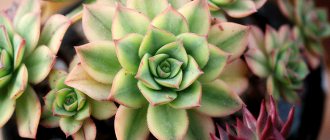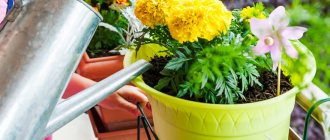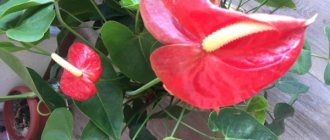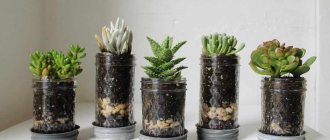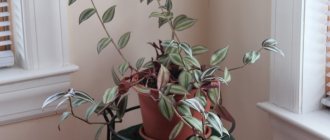This is not the first time I have noticed in shopping centers or on the windowsills of businesses that pebbles or stones are placed on TOP of pots with house plants.
Why is this being done?
Pebbles in flower pots perform not only decorative functions. And this is really beautiful. After all, sea pebbles look stylish, you can choose them in one color, white for example.
But pebbles also prevent the evaporation of moisture from the surface of the earth, and in large rooms where air conditioners operate, dry air is simply necessary.
Also, from my practice, I can say that when midges and other unnecessary living creatures disappear from the pots, the plant feels much better.
And yet, when watering a plant, earthen holes often form from the stream of water, and pebbles allow you to keep the soil at the same level, smoothing out such unnecessary impact. Thus, protecting the roots from exposure, the pebbles now perform a protective function.
It depends on how they are placed. The pebbles are for drainage. If they are placed on the bottom, this is so that the moisture does not stand in the pot and comes out through the holes.
If pebbles are placed on the surface, this is necessary so that the moisture does not evaporate quickly, that is, after watering, the moisture that was in the ground is retained.
There are also pebbles for decoration.
In general, a similar procedure is used in gardens in all different flower beds and flower beds to reduce the growth of grass and many ubiquitous weeds, which my wife successfully applied, covering almost the entire garden with fine gravel, in principle it is very convenient.
And in closed spaces, such as shopping centers, cinemas and simply in public places, this is a design solution, a kind of decor that emphasizes the style of this room. Well, at home, “God himself ordered” to add some beautiful, multi-colored pebbles or seashells to your favorite flower or exotic palm tree.
In this case, mulching the soil in the pot was done to make the composition even more decorative, although natural stone or its imitation would fit in here much better than an unnatural pink scattering. As noted, mulch is poured onto the surface of the soil for beauty, to reduce the evaporation of moisture from its surface, and also to prevent the growth of fungi (mold, for example). Mulch the soil with expanded clay, beautiful glass, natural and artificial pebbles, and even sand. The advantage of such material, in my opinion, is that the plant can be watered less often, especially this will solve the problem when you are not away. The downside is that it is very difficult to control the humidity under such a layer of mulch, especially in winter, when due to negative factors (little sunlight, hot radiators, dry air), the root system of plants rots and breathes poorly, especially when growing plants in pure peat soil. It is especially difficult on such days for succulents, like those in the photo, which in the fall and winter need the soil to completely dry out until the day of the pot, and the soil should not remain damp for a very long time. Here you need a “tough hand”. But it will be good for desert cacti, which are not watered at all from autumn to spring; such mulch will not cause any special problems, if, of course, in the summer you also follow the watering rules and the necessary lighting.
Everyone, even the most inexperienced gardener, knows that when planting a houseplant in a container, drainage must be done. However, not everyone knows that installing a drainage layer in a bowl is not as simple as it seems at first glance. Why do indoor plants need drainage, what layer of drainage should be poured and what materials should be used? There really are a lot of questions. Let's try to figure it out and start from the very basics.
So, drainage for indoor plants is a system whose main function is to remove excess moisture. It includes both the flower pot itself, equipped with special holes in the bottom, and a special layer of water-permeable materials. In addition, the drainage system also includes soil that has water- and breathable properties.
Perhaps all lovers of indoor flora understand why drainage is needed. Under natural conditions, rainwater passes freely through the soil, nourishing plants, but without stagnating. The excess goes deep underground, forming groundwater. In addition, not only the above-ground part of the plant (trunk, branches, leaves), but also the underground (root system) must be supplied with air. And if in the natural environment there are no problems with this - oxygen and other necessary gases reach the roots with water and through the soil, then in home growing conditions the respiration of the root system is difficult.
The dense materials from which modern flower pots are made practically do not allow air to pass through. And where there is no air flow, the water begins to stagnate and turn sour, putrefactive processes occur, and pests multiply. All this ultimately leads to disease and death of the plant. That is why proper drainage is one of the most important steps when planting indoor flowers.
Is drainage really necessary? But what about those plants that grow in a humid environment (for example, cyperus) or those that, on the contrary, do not need frequent watering (cacti and succulents)? It's safe to say that all indoor plants need drainage, but the drainage system may vary. This depends both on the type of home flower and on the container in which it will be planted.
Materials
The main materials used to construct the drainage layer are:
- expanded clay,
- broken brick,
- clay shards, fragments of pottery,
- Styrofoam,
- pebbles, small crushed stone, gravel,
- charcoal,
- perlite, vermiculite
The use of each of them has both its pros and cons, which are sometimes overlooked.
Expanded clay
Perhaps the most popular material for drainage, sold in all supermarkets and specialized flower shops. The direct purpose of expanded clay is construction insulation, but the material is so well suited for creating a drainage layer that it has become widely used in floriculture.
Expanded clay or expanded clay gravel are particles of foamed and baked clay. The size of expanded clay fractions can be different - from coarse to small, almost sandy. In floriculture, as a rule, medium-fraction expanded clay (from 5 to 20 mm) is used.
One of the valuable properties of expanded clay, like other clay materials, is the ability to accumulate moisture and release it when necessary. Thus, an optimal water balance is maintained in the substrate.
Advantages of expanded clay used as a drainage material:
- availability and low price,
- light weight,
- ability to absorb water,
- durability (service life is at least 4-5 years).
However, using expanded clay also has its disadvantages. For example, according to some gardeners, it is capable of changing the acid-base balance of the soil, which negatively affects the health of the green pet.
[!] Sometimes it is useful to sprinkle expanded clay onto the surface of the substrate, eliminating overheating of the soil and excessive evaporation from its surface. However, in some cases this can lead to disruption of air exchange and the appearance of mold.
Recently, expanded clay enriched with microelements has appeared on the counter of flower shops. It’s hard to say whether it’s a miracle product or an advertising ploy to increase sales. You can only try it in practice and share your findings.
Broken brick
Red brick is a building material made from clay, so the properties of red brick chips are very similar to expanded clay. If, for some reason, it is not possible to buy expanded clay, you can completely get by with broken bricks, arranging a drainage layer from this material.
Clay shards, fragments of pottery
Another readily available material for drainage is shards and broken pottery. Some gardeners collect broken cups and plates, using them later to create a drainage layer.
And this is quite justified: they are light in weight, do not absorb or retain moisture. The only disadvantage of the fragments is the sharp corners, which can easily injure you, so it is better to work with such drainage material while wearing thick gloves.
Styrofoam
Recently, a new trend has emerged among flower growers - using pieces of polystyrene foam as drainage. And while some people are distrustful of this synthetic material, others, without hesitation, fill the bottom of a flower pot with it.
Polystyrene foam is, in fact, foamed, cellular plastic, and it is used everywhere, from construction to packaging of various goods. Foam plastic, as a drainage material, has many advantages:
- availability,
- sterility (does not create a favorable environment for the development of fungi),
- lack of absorption.
Polystyrene foam does not absorb or release moisture at all, which, in some cases, is its undeniable advantage. If the grower needs a drainage layer that retains water, a little hydrogel can be mixed into the pieces of polystyrene foam.
However, this material also has some disadvantages, for example:
- the ability of roots to grow through the foam (which makes it difficult to remove during transplantation),
- too light weight.
The last property of the material creates some inconvenience when using it in light plastic pots: unstable dishes with a weak base can tip over under the weight of the plant. On the other hand, the lightness of polystyrene foam is an undoubted advantage when filling bulky ceramic dishes. This material will not add weight to an already heavy flower pot.
Pebbles, crushed stone, gravel
Another free drainage material used by many indoor plant lovers is small pebbles: pebbles, crushed stone or gravel. The use of small fragments of stones is quite justified - they allow water to pass through perfectly without retaining or absorbing it.
Proper drainage of house plants
The health and even life of the green pet ultimately depends on how correctly the gardener organizes the drainage system.
With all the abundance of flower pots, one cannot help but notice that the vast majority of them are plastic pots. Experienced gardeners even make additional drainage cuts in the side of the pot when replanting this orchid. The ability of such plants to grow in swamps in their natural habitat does not mean that they can exist in the waterlogged soil of a flower pot. Consequently, fewer holes are made in the pot. But first of all, you must become familiar with the peculiarities of growing each specific type of indoor flower.
This is the cheapest and most readily available drainage material. Moreover, unlike bricks, pebbles and shards, polystyrene foam is much lighter, which means it does not weigh down the pot.
Both the upper foliage part of the plants and the root system must be able to breathe.
This procedure is not limited only to the presence of holes; it is also necessary to use special drainage material.
You need to put the pot on its side and clean them with a stick. Some types of plants have such a developed root system that it fills the entire space of the pot. Through the drainage holes, the roots will be clearly visible and you can easily monitor their condition.
Only materials of inorganic origin are suitable for creating a drainage layer. For example, marble chips are absolutely not suitable for drainage, since with prolonged interaction with water, they significantly reduce the acidity of the soil, making it excessively alkaline.
However, not everyone knows that installing a drainage layer in a bowl is not as simple as it seems at first glance. The drainage system also includes soil that has water- and breathable properties. That is why proper drainage is one of the most important steps when planting indoor flowers. It's safe to say that all indoor plants need drainage, but the drainage system may vary.
You can purchase drainage mixture at a flower shop or at a construction site if, for example, you decide to buy crushed stone. After planting flowers, it is worth checking whether the drainage system works well.
Almost all beginning flower growers believe that drainage is the same expanded clay that is sold in stores. The main one is increasing the acidity of the nutrient solution that the roots consume. You can agree with this statement, or you can argue. In any case, your humble servant has been using expanded clay as a drainage material for many years, and has not noticed any negative effect on plants. Therefore, their calibration and cleaning falls on the shoulders of the grower. At its core, this is also a pretty good drainage material. Before creating a drainage layer from broken bricks, it also needs to be prepared.
The largest shard is placed at the bottom of the pot, in the center of which a hole is made. Then the main substrate is added and the plant is planted. Foam plastic is excellent as drainage for flowers. Poinsettia from the Euphorbia family is an amazingly beautiful plant.
Can such pain be tolerated? How much money have you already wasted on ineffective treatment?
The use of organic materials for drainage - nut or eggshells, tree bark - is strictly prohibited. For more information, you can watch a video on how to make your own indoor plant drainage. It is prohibited to use materials such as marble and granite chips, especially the first one, as drainage.
Common Mistakes
When installing drainage, inexperienced gardeners often make mistakes that lead to disease and even death of plants. And the most important of them is the use of inappropriate materials. There are several of them:
- sand
- tree bark, tea leaves, nut and egg shells
- marble and granite chips.
So, for example, sand at the bottom of a flower pot will not only not drain away, but will also retain water, preventing it from evaporating. And a violation of the water balance will lead to acidification of the soil and the development of putrefactive processes, which in turn will negatively affect the health of the plant. In addition, sand can completely clog the drainage hole.
Tree bark, tea leaves, nut and egg shells are components of animal and plant origin that may contain a number of pathogens. Because of this, there is a high probability of mold and other fungal diseases developing in the substrate.
Shards of granite and marble enter into a chemical reaction with water and can change the acid-base balance of the soil.
Another common mistake made by beginners is letting water stagnate in the tray of a flower pot. The fact is that if excess moisture is not drained, the drainage system simply will not work. For the vast majority of plants, the tray must be emptied of excess water 30-40 minutes after watering.
Here, perhaps, are all the nuances of arranging proper drainage in a flower pot.
Healthy appearance and abundant flowering often depend on the use of drainage for indoor plants. Flowers without a drainage layer grow poorly, get sick and die over time. It is not difficult to make drainage yourself. The materials for the day are often already in your home.
Why do you need drainage for indoor plants?
The ideal balance of components in which an indoor flower grows looks like this:
- 15% oxygen;
- 35% water;
- 50% solids.
The first two indicators provide drainage, removing excess moisture and providing air flow to the roots from below the pot.
Different material on the bottom performs the same function
Drainage is a system that provides optimal moisture and breathing of the root system in the soil mixture. The system includes a drainage layer, moisture removal holes and auxiliary materials. The latter are mixed with the soil and allow them to retain moisture and provide the necessary conditions for plants.
Interesting to know! The most ardent fans of drainage are succulents, especially cacti, representatives of the bromeliad family and orchids.
The layer is made from materials that:
- allow water and air to pass through well;
- they can be easily disentangled from the roots during transplantation, and also do not damage the roots with sharp edges;
- do not enter into chemical bonds with the soil mixture;
- protected from the effects of rot and mold.
The average thickness of such a layer is 2-3 cm. It all depends on the requirements of the flower itself to the level of moisture in the soil
It is also important what size the pot is and what holes are in it
Soil quality does not affect the availability of drainage material
Functional purpose of the holes in the pot
The most direct purpose of a holey bottom of a pot is to remove excess water. Stagnation of liquid causes the roots to rot. Also, air passes through these holes to the roots and provides ventilation of the soil in the pot.
Bottom ventilation directly depends on the amount of soil mixture that needs to be drained. The type of green handsome man plays an important role. Epiphytes need ventilation not only at the bottom of the pot, but also along its walls.
The height of the layer of stones at the bottom of the pot is tied to its ability to pass water:
- One hole with a diameter of at least 1 cm at the bottom of the ceramic pot must be covered with a layer of at least 3 cm.
- The average number of small holes in a plastic pot provides 5 cm of drainage.
- If the bottom is wide and there are a lot of holes in it, a layer of 1 cm will be enough.
Drained bottom
Other elements and basic requirements
Soil drainage aids include hydroabsorbents and mineral additives to the soil. They are able to retain moisture in the substrate, distributing it correctly. They keep the soil moist and prevent water from evaporating (relevant for the summer). They serve as soil orderlies, removing harmful salts and toxins.
An auxiliary item for drainage holes is a liquid tray.
Important! It is necessary to drain all the water from the pan 30 minutes after watering. Such an environment will acquire fungi, mold and parasites.
Drainage and its purpose
Many houseplants require a soil composition that provides approximately 50% solids, 35% water and 15% air. Only a properly laid drainage layer will help recreate optimal conditions for growth and flowering.
The problem with lack of drainage is that overwatering displaces air, which is vital for flowers. The lack of oxygen in the soil provokes the development of pathogenic bacteria. The root system begins to rot and the plant withers. The drainage layer ensures the outflow of excess moisture and good breathability.
Indoor plants and drainage in pots
Sphagnum moss
This natural material works best for drainage. It not only absorbs excess moisture, but also holds it for a while, gradually releasing it into the soil. Moss also disinfects and heals the soil, making it looser and more breathable.
You can stock up on this material in a swampy forest, and moss should be stored in a cool place. Before placing it in a pot, sphagnum must be soaked in water for 30 minutes and only then used.
It is impossible to do without drainage when transplanting potted crops, otherwise they may die. Among the proposed options, you will surely find the best one for yourself and at the same time you will be able to save a little on purchasing special material at a flower shop.
What can be used as drainage
To lay drainage, you can use materials such as gravel, expanded clay, crushed stone, broken brick, peat, charcoal, river sand, polystyrene foam or any synthetics. An important quality of the drainage layer for indoor plants is good moisture permeability, inertness to chemicals, resistance to rotting and mold.
Drainage has different fractions, which are selected depending on the flower.
Expanded clay for flowers
A material with a porous structure, expanded clay, is baked clay. It is used in construction as an effective sound insulator and insulation. In floriculture, fine- and medium-fraction expanded clay is used. The main advantages are lightness and ability to absorb water. When the earthen ball dries out, the material releases moisture back into the soil.
Expanded clay is a chemically neutral, odorless material. It can be used several times. After about 6 years it crumbles into the ground. For drainage of large indoor plants, medium-fraction expanded clay (diameter 2 cm) is suitable. It is important that the size of the hole at the bottom of the pot is smaller than the fraction of the material. The optimal height of the drainage layer is 2 cm. If you are using a container without holes, then the expanded clay layer should be 5 cm. Sprinkle sand on top.
Layer of expanded clay in a pot
Ceramic shards
Pieces of ceramics will serve as a good drainage material for indoor flowers. Place several small shards or large pieces with the convex side up on the holes in the pot. Pour 1.5 cm of purified coarse sand on top into a small container, and 5 cm into a large container. The disadvantage of the material is the risk of damage to the roots by the sharp sides of the shards. You should not use pieces of ceramic that are too large, as sand will spill through them.
Ceramic shards
Perlite and vermiculite
The material vermiculite is produced by heating clay to high temperatures. As a result of heat treatment, minerals are pressed together, forming flakes. In appearance, vermiculite resembles wood or cork shavings. It is light, inert, and does not harm indoor plants.
Perlite is elastic silica of volcanic origin. It appears as white or gray granules. Both materials are capable of absorbing moisture with mineral and organic substances. They return water back to the soil as needed. The disadvantage of this type of drainage is its high cost.
Perlite and vermiculite
Sphagnum moss
Many gardeners use pure sphagnum moss as a drainage material. This natural drainage holds water well and releases it to dry soil. In addition, it has disinfecting properties. Moss grows on moist, swampy forest soils. It consists of soft stalks of light green light, from which the same soft needle-like leaves grow to the sides.
How to replace drainage for flowers
Special drainage for home flowers can be replaced with something that has similar properties. In this case, you don’t need to buy it, just go out into the yard or rummage through the pantry. Examples of a drainage system made from scrap materials:
- Brick . Before use, it is split into small pieces and calcined in a frying pan or in the oven. Sand-lime brick is more suitable for drainage construction, as it is able to absorb water, which it subsequently releases to the plant when the soil dries. The downside is the presence of sharp edges that can harm the roots.
- Gravel and crushed stone . Due to their large size, the use of these materials is advisable for creating a drainage layer in the garden. Only fine stones are suitable for indoor flowers. Before placing them in a pot, they are also calcined to destroy harmful microorganisms. The downside is that the stones are very massive, so they significantly weigh down the flower pot.
- Styrofoam . This is a cheap, porous material that can be used instead of moss. Before use, it must be torn into small pieces and disinfected with a dark solution of potassium permanganate. It doesn't have any special advantages. The downside is that roots grow through the foam.
- Cork . If you didn't throw away wine corks, you can cut them into bars and use them as drainage. Their properties resemble polystyrene foam, but it is more difficult for roots to break through the cork.
The available substitutes for drainage materials do a good job of their functions. Although they have more negative sides than special ones. But this does not prevent flower growers from using them for various plants.
Why are drainage holes needed in a flower pot?
In addition to proper drainage, it is important to find a good pot for planting. When purchasing a container, pay attention to whether it has drainage holes, what size they are and how they are located. If the holes are too small, the moisture will drain slowly, if they are large, the moisture will drain quickly. If there are no holes at all, they can be made at home using a drill with a suitable drill diameter.
To ensure the correct soil moisture for certain indoor plants, you should choose a container with the correct holes:
- For succulents, cacti and some types of orchids, moisture must drain quickly. A small pot with porous soil and small holes is suitable for them.
- For plants growing in high humidity, it is better to select containers with dense soil and a minimum of small holes.
Drainage holes in flower pots
How to make a drainage layer
When the drainage material and planting container are prepared, you should proceed to installation. Step-by-step instructions on how to make drainage in a flower pot at home:
- Before starting work, make sure that all tools are clean and disinfected. Containers for planting must be dry.
- Before installation, carefully read the instructions for the drainage material; some of them require pre-soaking.
- Be sure to replace the drainage material with a new one when planting, transplanting, including during emergency procedures. If crushed stone or expanded clay is used, they should be washed, disinfected, dried, and then reused (maximum service life is 6 years).
- Select the layer height depending on the requirements of a particular plant. If the care recommendations do not indicate what kind of drainage is needed, then use low or medium. The usual drainage layer is 1–3 cm, medium – 4–5 cm, high – more than 5 cm.
- Adjust drainage height based on the number and diameter of drainage holes if necessary. If there is 1 large hole in the pot, then increase the minimum layer to 3 cm. For small holes, only high drainage is suitable. If there are many holes and they are large, then limit yourself to a layer 1 cm high.
- It is important that the drainage material lies evenly. To do this, tap the pot on the sides or shake it a little. If you are using shallow drainage, add a thin layer of soil on top. For coarse drainage material, add coarse sand.
- Completely cover the drainage layer and level the soil or sand. After this, proceed to transshipment or planting of a house plant.
Drainage layer
How to properly install drainage
In order for drainage for indoor flowers to fulfill its main purpose - to remove excess water introduced into the soil and thus prevent the process of rotting, the following rules should be taken into account:
First you need to disinfect the container in which the plant will be planted.
Then the same disinfection manipulation is carried out in relation to the drainage. It is either doused with boiling water or kept in the oven for a fairly long period of time (about 15-20 minutes). This calcination allows you to get rid of possible infections and parasites and prevent infection of your indoor plant. It is important to understand that such manipulations are carried out only when drainage for indoor plants is done with your own hands. If store-bought mixtures are purchased, then, as a rule, they do not require additional processing.
After this, drainage material is laid out at the bottom at the required height. The soil mixture is poured on top, a depression is made in it and a houseplant is planted.
Errors in the manufacture of drainage
Flower growers often make mistakes when making drainage:
- Do not use fine sand, which will clog the water drainage holes over time.
- You should not use large fractions, which do not retain moisture at all, and it immediately flows into the pan.
- Do not use natural materials that tend to rot, such as sawdust or tree bark. The rotting process often provokes plant diseases.
- It is not advisable to use marble chips. This material, when interacting with water, changes the acidity of the soil.
- It is not recommended to use materials with sharp edges: they can damage the root system of the plant.
Preparing to replant indoor flowers
Before you start replanting the flower and filling in the drainage, you need to make sure that the materials used are clean. The drainage must be filled in before planting; it should not be wet, and if it has been used previously, it must be thoroughly washed and disinfected.
Containers for planting should be pre-cleaned and dried; you should check the recommendations for the store-bought substrate: many types of materials should be moistened. In this case, you should place the drainage in prepared purified water.
While watching the video you will learn about drainage.
Drainage is a system that maintains the required substrate moisture for the vegetation grown at home. The use of drainage is a very important process for planting and replanting plants.
For the most comfortable development of the plant, experienced gardeners recommend creating a favorable atmosphere for the flower. External factors affecting the growth and development of a flower can be considered sunlight, air humidity, ambient temperature and the drainage system. And this is a rather important point, because properly selected drainage can significantly affect both the flower itself and failures in care. Read about how to perform drainage on the site.
Drainage for flowers - what is it?
Floral drainage is a system that allows excess moisture to be removed through the root system of the flower and the soil layer. A plant is a living organism, therefore it needs to breathe. All parts of the plant need access to oxygen:
- Leaves;
- Root system;
If for any reason a grower floods a flower with water, it will literally displace all oxygen bubbles from the soil layer. An anaerobic environment promotes the development of various types of bacteria. An airless environment leads to rotting of the root system, and the flower fades as a result.
The essence of the “work” of the drainage system is to remove excess moisture from the plant and allow the root system to breathe without problems. Read and how to seat it.
Therefore, each flower needs:
- Have at least one small drainage hole at the base of the flower pot. It is necessary so that excess water comes out through it, plus this hole allows air to circulate.
- At the very bottom of the pot it is necessary to lay out a layer of 2-5 cm (depending on the type of plant) of drainage.
Drainage for flowers, photos of varieties
Today you can not only buy drainage for a plant at a flower shop, but also make it yourself.
There are different types of drainage for flowers:
- Expanded clay drainage for flowers, the best-selling and popular type of drainage. Only certain types of fractions (fine and medium) are used for drainage;
- Styrofoam as drainage for flowers is the most readily available substance that has ever been used to create a drainage system. It is not affected by mold, is moisture resistant, chemically inert and does not decompose;
drainage based on pieces of tiles or ceramic; only a few pieces of pottery are needed for drainage; drainage made of crushed stone and gravel, it is often used in garden plots, such a drainage system will last for many years;
drainage from sphagnum moss. The best option for drainage for indoor plants. Able to retain moisture, disinfectant;
charcoal drainage. It has good antiseptic properties and can be used as a fertilizer; broken brick drainage. Not the best option for drainage. Sharp corners can damage the plant's root system;
Vermiculite drainage perfectly absorbs liquid fertilizers and water. It can serve as a top dressing months after its implementation.
by place of application:
- drainage for indoor flowers;
- drainage for garden plants;

